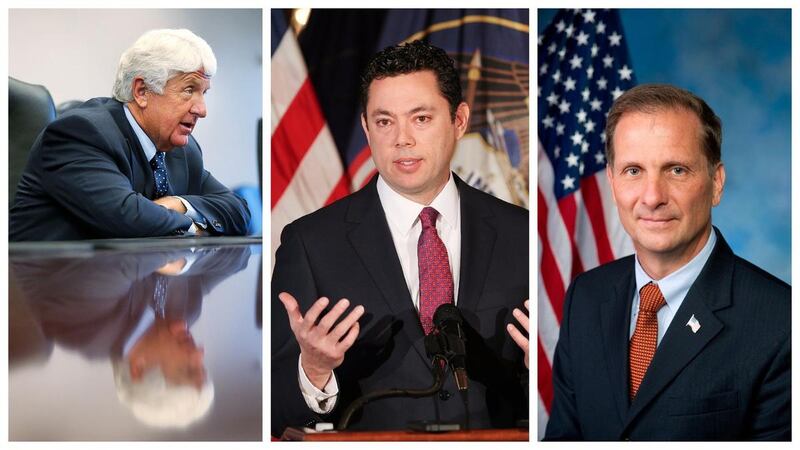Do you recognize that you are creating some really bad publicity for the BLM across the country? – Rep. Bruce Westerman, R-Arkansas
ST. GEORGE — Members of a congressional subcommittee skewered the acting director of the Bureau of Land Management of Utah Friday over a proposed land use plan they say ignores the will of residents and the letter of a 2009 public lands law for Washington County.
"We are here because Congress is hearing a crescendo of complaints about BLM tactics and policies across the country, and St. George seems to be a poster child of BLM bad behavior," said Tom McClintock, R-California and chairman of the House Natural Resources Federal Subcommittee.
"We are here to get to the bottom of it."
The subcommittee convened the rare field hearing after McClintock said they'd heard a litany of complaints over the BLM's draft resource management plans proposed for the Beaver Dam Wash and Red Cliffs National Conservation Areas.
The plan is being crafted as a result of the 2009 Public Lands Omnibus Act, which McClintock said embodied the spirit of compromise and was held up as a model for locally generated public lands planning across the nation.
"This subcommittee doesn’t normally hold hearings on individual land use plans. But it appears that the BLM, which administers nearly half of the land area of Washington County, has ignored the will of Congress and thumbed its nose at the people whose taxes support this government and whose livelihoods and quality of life are now directly threatened by it."
The agency's preferred action in the land use plan released last year proposes to reduce grazing by 40 percent in those national conservation areas, restrict St. George's access to up to 37 percent of its water and does not include a northern transportation corridor through the Red Cliffs area in Washington County, according to critics.
Washington County Commission Chairman Alan Gardner and St. George Mayor Jon Pike both testified at the hearing — held at the Dixie Convention Center in St. George — that they were left out of BLM's planning process and surprised at the plan's components when it was released.
"I would have expected to have had many discussions with the BLM about all of these issues that have been raised today," Pike said, particularly since they concern water rights. "I would have liked to have had those conversations before the plan was released."
Acting BLM Utah Director Jenna Whitlock defended her agency and disputed the allegation local elected officials were not involved in the planning stages.
"We really feel like we have a good record," she said, adding she believes the proposed plan follows the 2009 law.
The hearing, which was attended by Utah Reps. Jason Chaffetz, Chris Stewart and Rob Bishop, drew sympathetic comments from Rep. Bruce Westerman, R-Arkansas, who said these divisive land issues impact everyone.
"These issues are not only important to not only Utah, they are important to the whole country," he said, adding that he had read about the controversy 1,000 miles away in his home state. "It appears to me that the law is being ignored, this law passed by Congress. This seems to be a pattern with the BLM. … Do you recognize that you are creating some really bad publicity for the BLM across the country?"
Friday's hearing was packed with members of the public sporting "Wild Utah" pins who are supportive of BLM's planning efforts that are designed to conserve the desert tortoise, which was added to the Endangered Species list in 1990 and conserve desert landscapes.
Paul Van Dam, one of the witnesses who testified at the subcommittee hearing, said the BLM is a responsive agency and was engaged with the public while it crafted its proposed plan.
"I have dealt with the BLM for a long time," said Van Dam, who used to head up the grass-roots environmental organization called Citizens for Dixie's Future. "My experiences are positive."
But critics said it was if the BLM tossed the law aside and instead pulled out a wilderness manual to craft the proposal.
"The time for negotiations over this has passed," said Kathleen Clarke, director the Utah Public Lands Policy Coordination Office. "It is an agency not bothering to read the law. They just know where the wilderness manual is and that is what they are doing."
Clarke said the only reason local elected leaders agreed to designate conservation or wilderness areas is they thought they would get something in return.'
"What are agreements if there is no honor behind them or no real commitment behind them?"
Gardner has said the county is considering legal action depending on the final shape the BLM plan takes.
During the hearing, Bishop emphasized that Whitlock should scrap the agency's proposal and start over.
Afterward, he said what ultimately happens on those two national conservation areas should be a matter of ethics for the land planning agency.
"I hope it was clear enough that BLM has a moral imperative to try to do it the right way."
Email: amyjoi@deseretnews.com
Twitter: amyjoi16


